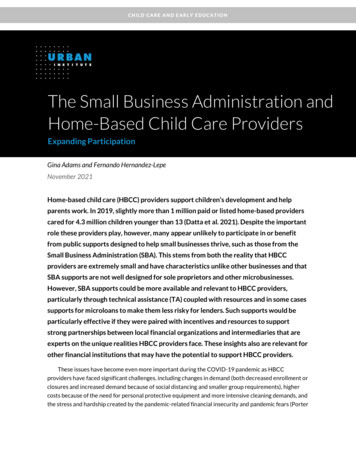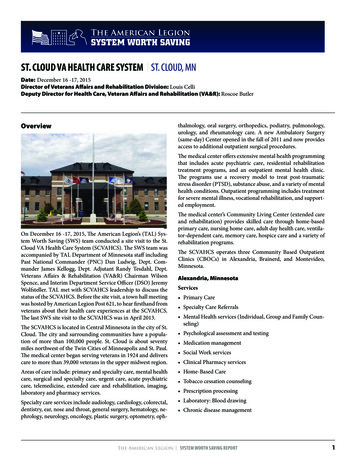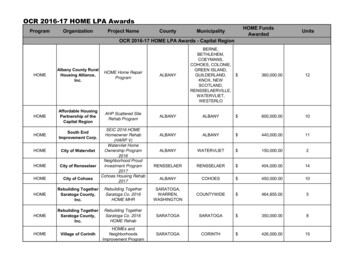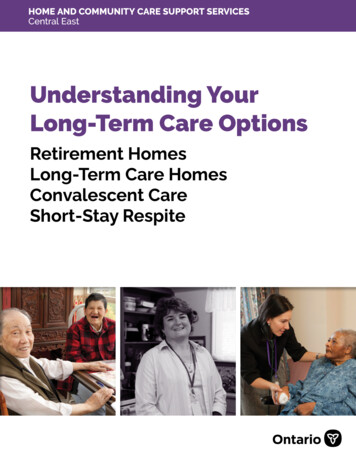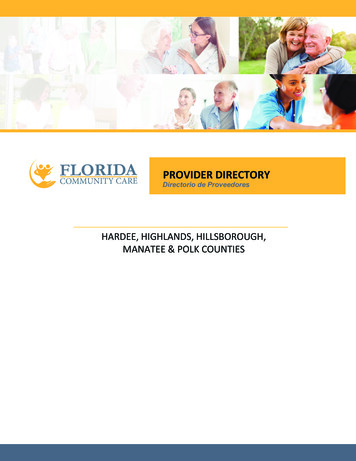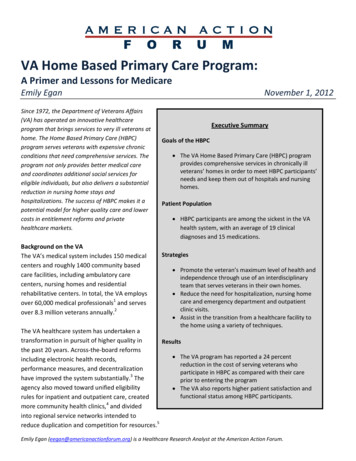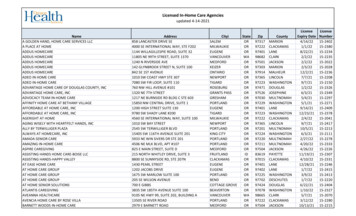
Transcription
Community and Home-based Care in NepalFindings and Recommendations froma National Program ReviewJune 2007A Joint NCASC/GON, USAID and ASHA Project CollaborationASHAAdvancing Surveillance, Policies, Prevention,Care and Support to Fight HIV/AIDSMinistry of Health & PopulationNational Center for AIDS & STD Control
In July 2011, FHI became FHI 360.FHI 360 is a nonprofit human development organization dedicated to improving lives in lasting ways byadvancing integrated, locally driven solutions. Our staff includes experts in health, education, nutrition,environment, economic development, civil society, gender, youth, research and technology – creating aunique mix of capabilities to address today’s interrelated development challenges. FHI 360 serves morethan 60 countries, all 50 U.S. states and all U.S. territories.Visit us at www.fhi360.org.
Community andHome-based Carein NepalFindings and Recommendations froma National Program ReviewJune 2007A Joint NCASC/GON, USAID and ASHA Project CollaborationASHAAdvancing Surveillance, Policies, Prevention,Care and Support to Fight HIV/AIDSMinistry of Health & PopulationNational Center for AIDS & STD Control
ForewordWith more than 70,000 people estimated to be living with HIV in Nepal, there is an urgent need to scaleup HIV care, Support and treatment services. Community and home-based palliative care (CHBC)services form a very important part of the care package that needs to be available to people livingwith HIV (PLHA) and their families. The importance of CHBC and the future plans of NCASC to supportthese services are outlined in the national HIV/AIDS strategy for 2006 - 2011 and Nepal's plan toachieve universal access to HIV prevention and care services by 2010.In order to better support the rollout of CHBC services, NCASC with assistance from USAID and FHIconducted and national review of services. This review entailed in-depth assessment of the servicesmodel and quality of care of nine CHBC programs across Nepal. It also included interviews with nearlyone hundred PLHA and family caregivers, and more than seventy key informants. A range of keystakeholders were involved in the assessment including WHO and UNAIDS; several NGO and PLHAgroups and government officials and health care providers from District Health Offices (DHOs/DPHO),District AIDS Coordiantion Committees (DACCs) and hospitals.It is sincerely hoped that the findings and recommendations from this report will help guide futureimplementation and scale-up of community and home-based palliative care services in areas ofneed in Nepal.NCASC is deeply committed to working closely with partners put into action the keyrecommendations from the review.I would like to sincerely thank those who generously contributed their time and energy to conduct theCHBC review, including representatives from USAID, FHI, the National Association fo People LivingHIV/AIDS in Nepal (NAP N), Sakriya Sewa samaj, Nava Kiran , Youth Vision, Naulo Ghumti andSPARSHA.I would also thank all those in NCASC who participated in and provided thoughtful comments to thisvery important national assessment.Sincerely,Dr. Padam Bahadur ChandDirectorStop AIDS, Keep the Promise
Table of ContentsExecutive Summary1Summary of Key Findings and Recommendations2I.Background7II. CHBC Program Review Objectives and Methodology11III. Findings171. CHBC Program Findings: Services, Systems, Successes and Challenges172. Perspectives of PLHA clients and family caregivers on CHBC services253. Perspectives of Multilateral Organizations, PLHA groups & NGOs on CHBC in Nepal304. Role of the DPHO, DACC and local health services in CHBC315. Role of NCASC in Leading CHBC32IV. Recommendations33V. Conclusions37Annex 1 - CHBC Program Review Team38Annex 2 - Key Informant Interview Participants39References40
DFHIFSWHIVHMGIBBSIDUINFKIM&EMoHPMSMNAP DSUSAIDVCTWATCHWHOAcquired Immune Deficiency SyndromeAntiretroviral TherapyAntiretroviral (medicines)Community Development ForumCommunity and Home Based CareContinuum of CareDistrict AIDS Coordination CommitteeDepartment for International DevelopmentDirectly Observed Treatment, ShortcourseDistrict Health OfficeFemale Community Health VolunteerFocus Group DiscussionFamily Health InternationalFemale Sex WorkerHuman Immunodeficiency VirusHis Majesty's GovernmentIntegrated Bio-behavioral SurveyInjecting Drug UserInternational Nepal FellowshipKey InformantMonitoring and EvaluationMinistry of Health and PopulationMen who have Sex with MenNational Association of People Living with HIV/AIDS in NepalNational Center for AIDS and STD ControlNon Governmental OrganizationsNepal National Social Welfare AssociationOral Rehydration SolutionPeople Living with HIV and AIDSPrevention of Mother-to-Child TransmissionQuality Assurance/Quality ImprovementStandard Operating ProcedureSociety for Positive Atmosphere and Related Support to HIV/AIDSSexually Transmitted InfectionTuberculosisJoint United Nations Program on HIV/AIDSUnited States Agency for International DevelopmentVoluntary Counseling and TestingWomen Acting Together for ChangeWorld Health Organization
QuotesQuotes from people living with HIV“The home-care service is a life-line, without it we would not be alive today”- PLHA, Kanchanpur“CHBC is hope, that's why we named our group New Hope”- PLHA, Kanchanpur“If CHBC team had not come to my home I would be dead”- PLHA, Pokhara“CHBC is a friend to our heart”- PLHA, Pokhara“Now that the team has helped us live, we need help with living”- PLHA, Doti
Executive Summary“The home-care service is a life-line, without it we would not be alive today”- Female PLHA, Focus Group Discussion, KanchanpurIn Nepal there are an estimated 70,000 people living with HIV (PLHA). To address the HIV care needs ofthose living with HIV, the National Centre for AIDS and STD Control (NCASC) draft strategy for 2006-2011details the need for expansion of HIV care services at every level through hospital and community andhome-based palliative care services to achieve universal access by 2010.As HIV care services have developed and expanded across Nepal, CHBC programs have grown froma few informal services in Kathmandu and Pokhara to eighteen programs meeting the needs ofseveral hundred PLHA. These services extend the entire length of Nepal and are available incommunities as diverse as mountainous Doti and the eastern Terai city of Dharan.In order to assess the quality and appropriateness of the increasing number of CHBC services, NCASC,United States Agency for International Development (USAID) and Family Health International (FHI)initiated a formal review of a sample of nine CHBC programs in Kanchanpur, Doti, Kapilbastu, Pokharaand Kathmandu. A team comprised of NCASC, USAID, FHI, the National Association of People LivingHIV/AIDS in Nepal (NAP N), Sakriya Sewa Samaj, Nava Kiran , Youth Vision, Naulo Ghumti andSPARSHA assessed the quality of CHBC services using a package of assessment tools including guidedinterviews, questionnaires and focus group discussions. A total of 74 CHBC providers, managers andkey informants were interviewed, 16 home-visits observed and 95 PLHA and family caregivers met withto assess perceptions of service quality.The review found that CHBC services are providing essential care to PLHA and their families. They aresignificantly contributing to the national response by reinforcing ART adherence, improved referralsand follow-up between the community and hospital, increased self-care and understanding of HIVdisease among clients and their families and reduction of stigma and discrimination in many of thecommunities where services are offered. PLHA, families and HIV clinics highly appreciate the careprovided through CHBC services and requested they continue and be made available to a greaternumber of PLHA.While the model of service delivery is effective there are missed opportunities in developing thecapacity and role of the public sector in CHBC services, particularly in areas where the District PublicHealth Offices (DPHO) and District AIDS Coordination Committees (DACC) are active and supportiveof community HIV prevention and care activities. One of the primary recommendations of the reviewis the need for increased cooperation with DPHO and DACC and where feasible, exploring models oflocal health care worker involvement in CHBC.Findings from the assessment clearly highlight the value of CHBC services and underscore the primaryrecommendation of the review: that NCASC continue to support increasing access to communityand home-based palliative care as part of its national strategy and identify ways in which to expandreach and integration or linkages of these services into the public health care system. It is hoped thatfindings from this review will help to guide the finalization of national CHBC guidelines; thedevelopment of SOPs, M&E program indicators and a CHBC medicine supply distribution system; andintegration of CHBC services into the DPHO, local public health care systems and the community.Page 1
Summary of Key Findings andRecommendationsKey findings²CHBC services are highly valued and appreciated by PLHA, families and hospital-based HIV careservice providers.Across all sites, in urban, rural, Terai and hilly regions, people living with HIV and their family membersreported deep appreciation of the services provided by CHBC teams. CHBC providers wererepeatedly referred to as life-savers or life-lines. Likewise, in areas where referral relationships existedbetween CHBC teams and the local hospital, hospital staff identified CHBC as a major support toclinical services including follow-up, timely referrals and adherence support. CHBC programmanagers and teams also reported being gratified by the impact of their work.²The CHBC service model is appropriate and effective but there are missed opportunities.Seven of the nine programs assessed were providing care of good quality to PLHA. A few (two) wereproviding excellent care. While there are improvements which could be made in all the programsassessed, the structure of the CHBC teams, their client load, and reporting and management systemswere in general appropriate and effective. It was clear that programs were making an effort tomaximize local resources to make the services as cost-efficient as possible. Several of the CHBC teamsinterviewed are already working at capacity and some were facing challenges in reaching clientswho live far from the program base Doti in particular poses a number of challenges in routine clientaccess.²Good coordination between CHBC services and hospital HIV clinics but less links with otherservices.All CHBC programs assessed had referral relationships with hospital-based HIV clinics and some hadvery active and dynamic systems. This included cross referrals by teams and hospital staff, clients beingaccompanied to the hospital to access services and telephone contact between teams and thehospital to follow-up on referrals and clients who had been discharged. In a few cases, CHBC teamsworked as part of the hospital HIV clinic and PMTCT services providing counseling, peer education orgeneral support. However, formal referral systems between the hospital and the CHBC service werelacking in many areas including Pokhara and Kathmandu. Hospitals interviewed in these areasrequested that a formal referral system be developed which included standardized referral forms andreferral standard operating procedures. Links with other HIV care services were not as evolved. Wherethe crisis center and CHBC service were offered by the same NGO, services were well coordinated.However, among crisis center staff interviewed in a stand-alone site, lack of coordination betweenCHBC services and the crisis center was felt to hinder referrals to/from the centers and the community.²Lack of national CHBC policies or guidelines.In the absence of NCASC CHBC guidelines or standards, CHBC programs are operating withoutcommon parameters of what constitutes quality of care. The lack of guidance has led to variations inthe overall quality of services provided. While the national training package has contributed toteaching CHBC teams to a certain standard of care, without national quality standards there is noPage 2
common basis from which to assess and judge the quality of care being offered. Guidelines andstandards are essential in all areas of health care and very important in ensuring a commonunderstanding and application of quality services.²National CHBC training certification package important to providing quality care.Across the nine CHBC programs assessed, the majority of providers had participated in the nationalCHBC training. From the assessment it was observed that those who had been trained were providinghigher quality care than those who had not yet been trained. However, many key informants felt thetraining was not long enough in order to help trainees master core skills. The training also does notinclude important areas of care such as caring for HIV infected and affected children and PMTCT.²Inconsistent availability of CHBC kit supplies.There is currently no national standardized CHBC formulary in place which describes which palliativecare medicines, nursing care materials and infection prevention supplies are at minimum part of aCHBC kit. There are variations in the types of CHBC medicines programs are using and different systemssome effective and some not soin managing the storage, distribution and restocking of CHBC kitsupplies. In nearly all programs, supply stock-outs were observed. A benchmark of quality services ishaving consistent and correct supplies needed to provide palliative care.²Need for further supervision support.All CHBC programs assessed had supervision systems in place, but only a few supervisors were routinelyaccompanying teams on home-visits and none were using the supervision checklist to guidesupervisory visits. Supervisors play a vital role in supporting teams to maintain quality of service.²Lack of coordination between CHBC programs and the DPHO, DACC and community level publichealth services.Despite relatively strong relationships between the CHBC teams and hospitals only a few CHBCprograms had developed relationships with the DPHO and DACCs. In many cases, the DPHO andDACC were unaware that the CHBC services existed in their area. Pokhara and Kapilbastu DPHO staffinterviewed were supportive of working closer CHBC services but Doti was the only site where theDPHO, DACC and local health workers were truly involved in CHBC services. In the remaining sites,there were no or limited connections between the CHBC service and local public health care system.²High expectations of clients from CHBC services.Many CHBC teams and managers were concerned by the expectations placed on CHBC teams toaddress the multiple social and economic needs of their clients. Areas which teams felt particularlyunable to address were helping client secure adequate livelihoods, food and care and schooling forchildren. A few (two) NGOs offering CHBC had successfully mobilized community, local governmentand NGO support to support client livelihood development, access to food and enrollment of childrenin school.Page 3
²Uneven involvement of PLHA in CHBC programs.PLHA need to be partners in the development, provision and assessment of CHBC services. The mostsuccessful CHBC programs in Asia are those which support mutually empowering, synergistic pairing ofPLHA with health care workers and social workers. While PLHA were involved in all services assessed,the level of involvement was variable. In some programs, PLHA were taking the lead or were equalpartner, in others this was not the case.²Lack of involvement of community in CHBC services.Most of the CHBC programs visited had not yet begun mobilizing support from community, localgovernment and NGO services. However, all services assessed identified the value of mobilizing thecommunity to support and be a part of CHBC. These included: 1) helping to meet the incomegeneration, nutrition, schooling and other support needs of clients which CHBC programs are not fullyable to address themselves, 2) reduce stigma and discrimination and 3) further build the sustainabilityand acceptance of the program in the community.²Limited knowledge and skills in PMTCT and caring for HIV exposed, infected and affected children.CHBC providers are seeing increasing numbers of children exposed to, living with and affected by HIVin their services and lack of basic skills in how to meet their physical, emotional, social and spiritualneeds. Many teams were also unfamiliar with the national PMTCT program and how to support clientaccess to and follow-up once enrolled in the service. This is in part due to the fact that pediatric HIVcare services are relatively new and that the initial CHBC training did not provide adequateknowledge and skills building in PMTCT and pediatric care.Page 4
Major Recommendations:1.Increase access to CHBC services and explore new service delivery models. CHBC programs areproviding much needed services to PLHA and families in Nepal and should be made availablewherever HIV care is needed and there is demand for the service. The current service model isappropriate but other models should be explored to maximize involvement of the public healthcare system. (See recommendation 5).2.Provide guidance and a policy framework for CHBC. NCASC can lead CHBC policy making byfinalizing and disseminating the draft national CHBC guidelines and by developing standardoperating procedures to promote a standard of quality care across all CHBC programs. Boththese steps are highlighted as part of the 2006-2011 National Strategic Plan for HIV/AIDS Control.3.Develop a CHBC drug supply chain management system. To ensure stable supply of essentialpalliative care medicines and supplies to CHBC programs - both government and NGO/PLHAgroup run - NCASC will need to lead a process of developing a system to provide standard CHBCkit supplies to CHBC programs. This recommendation recognizes that in many areas developing astable and functional drugs supply chain system in Nepal is a challenge. However, there are anumber of steps that could be taken by NCASC and partners in the immediate term to improveaccess to CHBC medicines and supplies which are described in the detailed recommendationssection of the report.4.Integrate CHBC into the national HIV M&E system. NCASC is in the process of developing programlevel indicators for technical components of the national strategy including ART and PMTCT. A setof core program indicators for CHBC should also be determined. These indicators should bereferenced in the national CHBC SOP including guidance and forms to be used in reporting inindicators. Tracking key indicators will improve overall mapping of service coverage andcontribute to universal access goals.5.Establish closer relationships between CHBC services and DPHO, DACC and local public healthsector. The DPHO and DACC are essential to strong, well supported CHBC services. Through theassessment, DPHO expressed interest and willingness to support and supervise CHBC services butthey also requested that: 1) NCASC provide them with guidance as to their role in CHBC; 2) theybe oriented in CHBC services and 3) that CHBC providers give them regular activity reports so theywere aware of achievements to date.6.Improve supervision and QA/QI systems. CHBC program managers need to be trained in what tolook for in assessing the quality of CHBC services. They also need to make a point ofaccompanying CHBC teams during home-visits and other activities to observe the quality of work.All managers should use a CHBC supervision checklist such as the one used in this programassessment. A system of routine (eg 6 monthly) QA/QI should also be instituted to comprehensivelyassess progress in improving quality of the CHBC program. The DPHO and DACC should be invitedto participate in or lead this process.7.Increase PLHA and community involvement in CHBC. It is recommended that programs which donot yet have strong involvement of people living with HIV in the program identify PLHA as teamPage 5
leaders and members. PLHA should be working as leaders and partners in all CHBC services. This isessential to quality care for PLHA. In most of the programs assessed, the community (including theDPHO and DACC) were not involved in the program. This is a missed opportunity to sensitizecommunity members to HIV, to reduce stigma and discrimination and to elicit their support. AllCHBC programs need a community mobilization component to their work. CHBC services shouldalso strive to work closely with crisis centers in their area to strengthen the continuum of care.8.Increase diversity of referral relationships to address social and economic support concerns ofclients. Only a few of the CHBC program assessed had actively sought and establishedpartnerships with organizations in the community which provide social and economic supportand care for orphans and vulnerable children. These formal referral relationships resulted in clientneeds in these areas being largely addressed. It is recommended that all CHBC programs mapkey services in the community offering assistance with livelihood, food security andsupplementation and support for orphans and vulnerable children and advocate for formalprogram and referral linkages.9.Train and support CHBC teams to provide family-centered care. CHBC teams need to be trainedto provide vital assistance in helping couples, pregnant women to access and remain in PMTCTservices. They also need to be trained providing follow-up care to mothers and infants includingsupporting infant feeding choices, cotrimoxazole prophylaxis, linkages to pediatric HIV testingand counseling, ability to recognize danger signs in mothers and children and refer, palliativecare and treatment support for children with HIV and care and support for children affected byHIV.Page 6
I. BackgroundContinuum of Care: Providing essential palliative care and treatment servicesThe ultimate goal of HIV care is to help people with HIV and their families live longer and better lives. Toachieve this, PLHA need access the multiple services over the course of their lives. If services offered atthe home, community and facility level are well linked they can provide an overall package of holisticcare aimed at addressing the physical, emotional, social and spiritual needs of PLHA and families. Thisnetwork of linked services is known as the continuum of care.Services which are essential to good care are palliative carean approach which improves thequality of life of patients and their families facing life-threatening illness through the prevention,assessment and treatment of pain and other physical, psychosocial and spiritual problemsandprovision of antiretroviral therapy. Palliative care includes the prevention and treatment ofopportunistic infections, management of pain and other symptoms, nutrition, and emotional, socialand spiritual support. Both palliative care and treatment need to go hand in hand to improve thewellbeing PLHA and their loved ones.While treatment services are generally provided through hospital and clinic-based services, palliativecare can be offered through many different settings including community and home-based careprograms, hospice, out-patient and in-patient clinical services, and centers caring for children withHIV.What is community and home-based palliative care?Community and home-based palliative care is a very important component of palliative carebecause it helps PLHA and families at different stages of disease cope with the many challenges of HIVincluding counseling and disclosure, healthy living and self-care, management of pain and othersymptom care, ART adherence and care for side-effects, access to social and other support services,end-of-live care and support to children and other affected family members. If CHBC services do notmeet a minimum standard of care in addressing physical, emotional, social and spiritual suffering thenthey do not qualify as palliative care programs but only as supportive care services.Studies have shown that CHBC services can increase ART adherence, family and communityacceptance, and improve quality of life. They can also reduce the overall cost of care for hospitalsand the health care system because it promotes rational use of services.CHBC is care in the home and community which responds to the physical, social, emotional andspiritual needs of PLHA and family from diagnosis to death and through bereavement. It aims toreduce suffering and increase quality of life by providing responsive care, increasing self-careskills, linking clients to needed services and empowering PLHA and families to manage HIV inthe home and community.Page 7
HIV in NepalThere are an estimated 70,000 people living with HIV in Nepal, the majority of whom are unaware oftheir HIV status. According to NCASC records, by the end of May 2007 there were 9532 peoplereported to be living with HIV, more than 70% of whom are male.According to NCASC 2005 data, HIV prevalence in Nepal is 0.5% among the general adult population.HIV prevalence is estimated to be 1.5% among female sex workers in the Terai highway districts, and52% among injecting drug users (IDU) in Kathmandu Valley (FHI/SACTS 2005). Estimates of prevalenceamong labor migrants returning from India range from 1-3%. However, HIV prevalence among themigrants who had sex with sex workers in India is estimated to be as high as 8% (IBBS, 2006). Men whohave sex with men are also highly affected by HIV. HIV prevalence is 3.9% among MSM and about 5%among male sex workers (IBBS, 2004).The majority of people living with HIV are located in the far west where the epidemic is characterizedby migration to and from India; the Terai where mobility, sex work and drug use are factors in exposureto HIV and in Kathmandhu, Pokhara and the East where injecting drug use is a major cause of HIVtransmission.Care, Support and TreatmentHIV care services are increasingly available in Nepal. An estimated 950 PLHA are now on ART and afew thousand receiving palliative care. Care services vary in quality but at minimum are offeringhospital-based anti-retroviral therapy and palliative care services for adults and, in some cases,children. Hospital based services include prophylaxis and treatment of opportunistic infections.In a growing number of sites in Nepal, formal community and home-based care (CHBC) services arebeing offered to PLHA and families as part of a continuum of care (CoC) approach. The CoC is beingimplemented to provide a network of linked care services from home and community to health carefacilities, facilitating improved access to and follow-up from HIV care services.Community and home-based Care in NepalCHBC at the policy levelThe National Center for AIDS and STD Control (NCASC) identified the need for community and homebased palliative care (CHBC) services in 2002, outlining a plan for delivering CHBC services in theNational Strategic Plan for HIV/AIDS Control 2002-2006. Over the course of this plan, NCASC, withsupport from the US Agency for International Development (USAID) and Family Health International(FHI), led the development of a national training certification program in CHBC. As a result more thanone thousand providers were trained in caring for people living with HIV and their families. NCASC alsoconvened a national working group which developed draft national guidelines on CHBC.The draft National Strategic Plan for HIV/AIDS Control 2006-2011 calls for a comprehensive CHBCprogram. Some of the key results and actions related to CHBC include:Page 8
Strategic results²Increased number of trained community workers, volunteers and family members in CHBC²Established linkages developed between health facilities and CHBC workers and programs²Increased availability of integrated and comprehensive services at the community levelKey actions²Ensure policies, strategies, guidelines and manuals for incorporating home-based care intooverall national health systems²Ensure core training competencies and curricula for community health workers andtreatment supporters²Endorse national guidelines for home care services, including basic palliative care by familymembers and community volunteers²Define comprehensive package for CHBC and ensure that services are adequatelydelivered and used and that the quality of care is maintained²Set monitoring and support systems for community based treatment supporters and careprovidersStatus of CHBC Services in Nepal: A Snap-shotHIV care services are relatively new to Nepal and CHBC is no exception. The first CHBC programs weredeveloped about two years ago with the majority starting in the past year. While services are relativelynew service, their development and client uptake has been rapid. During the course of the CHBCprogram review it was found that more CHBC programs are planned to start within the next year.There are currently eighteen CHBC programs in operation or planned in Nepal estimating to be1reaching more than 1000 people living with HIV . The CHBC service map below features the location ofknown current and planned CHBC sites. CHBC services are located in areas of higher prevalence,mostly based in NGO/PLHA group supported care sites (eg VCT/STI/HIV clinics).The findings in the section III provide more detailed information on the CHBC program approachesused by the nine CHBC services assessed in depth.1. This estimate is extrapolated from the average number of clients which the nine organizations included in the programreview care for.Page 9
Page 10
II. CHBC Program Review Objectivesand Methodology Objectives²The overall objective of the CHBC program review was to assess the level of quality of currentC
1. CHBC Program Findings: Services, Systems, Successes and Challenges 17 2. Perspectives of PLHA clients and family caregivers on CHBC services 25 3. Perspectives of Multilateral Organizations, PLHA groups & NGOs on CHBC in Nepal 30 4. Role of the DPHO, DACC and local health services in CHBC 31 5. Role of NCASC in Leading CHBC 32 IV .

